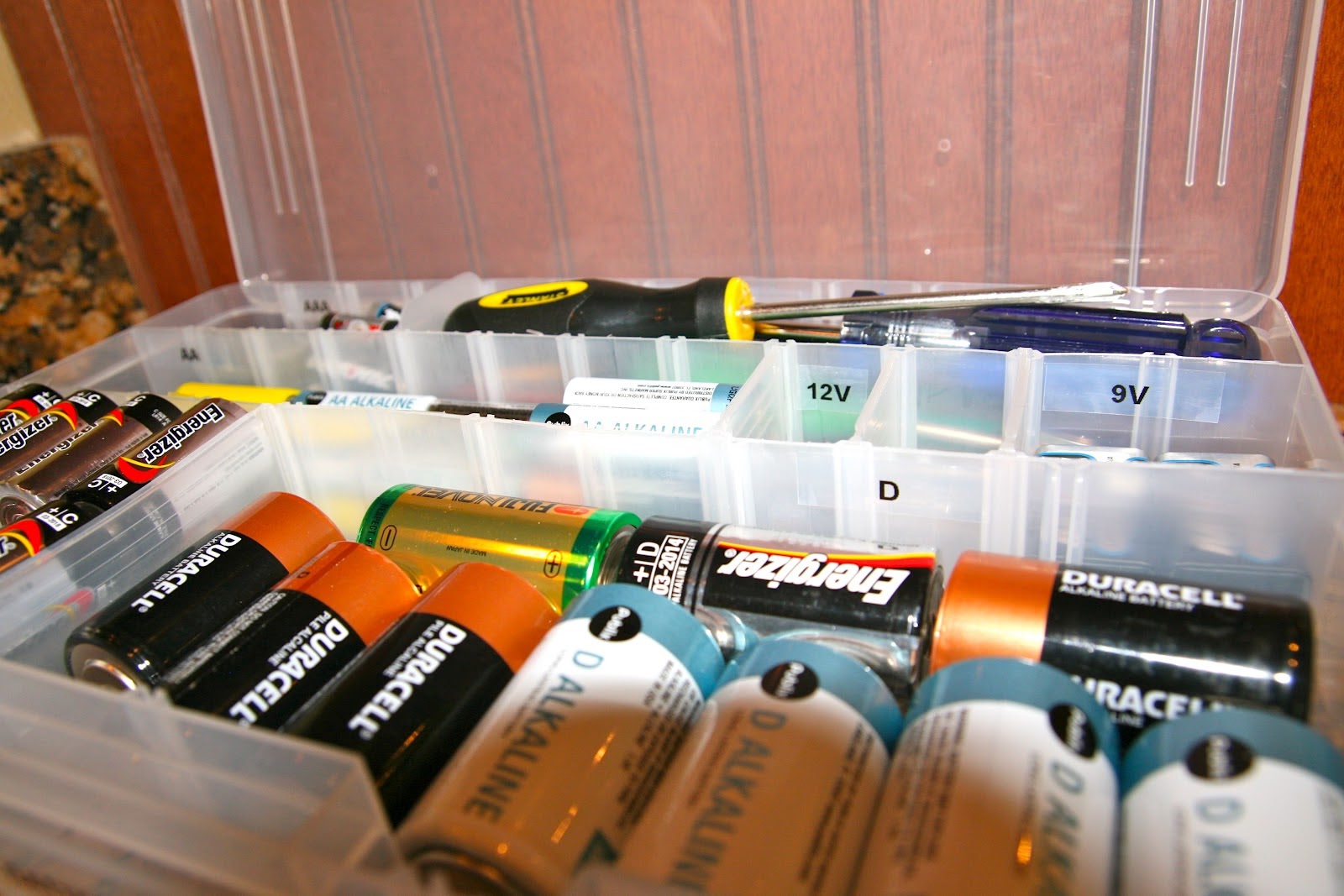

Articles
How To Store Batteries To Last Longer
Modified: January 9, 2024
Learn how to store batteries properly to extend their lifespan and avoid unnecessary waste. Read our informative articles for helpful tips and tricks.
(Many of the links in this article redirect to a specific reviewed product. Your purchase of these products through affiliate links helps to generate commission for Storables.com, at no extra cost. Learn more)
Introduction
When it comes to powering our devices, batteries play a crucial role. From remote controls to smartphones, batteries provide the necessary energy to keep our devices running smoothly. However, have you ever wondered how to store batteries properly to make them last longer?
Improper storage of batteries can lead to reduced performance and even leakage, causing damage to your devices. It’s important to understand the different types of batteries and the factors that affect their lifespan to ensure they are stored correctly.
In this article, we will explore various battery types and the best practices for storing them to maximize their lifespan. Whether you have alkaline batteries, lithium batteries, nickel-metal hydride (NiMH) batteries, or even lead-acid batteries, we’ve got you covered.
So, let’s dive in and learn how to store batteries effectively, ensuring they stay in peak condition and deliver optimal performance when you need them the most.
Key Takeaways:
- Proper battery storage is crucial for maximizing lifespan and performance. Different types of batteries require specific care, such as storing alkaline batteries in a cool, dry place and maintaining lithium batteries at room temperature.
- Factors like temperature, humidity, and charge cycles can impact battery lifespan. Avoid common mistakes like mixing battery types and neglecting to check their condition to ensure your batteries remain in optimal condition during storage.
Read more: How To Store Spinach To Last Longer
Understanding Battery Types
Before we delve into the specifics of proper battery storage techniques, it is essential to have a basic understanding of the different types of batteries available in the market. Each battery type has its own unique characteristics and requires specific care and handling.
1. Alkaline Batteries:
Alkaline batteries are commonly used in a wide range of devices, including remote controls, toys, and clocks. They are known for their long shelf life and reliable performance. Alkaline batteries have a higher energy density compared to other battery types, making them a popular choice for everyday use.
2. Lithium Batteries:
Lithium batteries, also known as lithium-ion batteries, are widely used in smartphones, laptops, tablets, and other high-powered devices. They offer a higher voltage and energy density, providing longer-lasting power. Lithium batteries also have a longer overall lifespan and can be recharged multiple times.
3. Nickel-Metal Hydride (NiMH) Batteries:
NiMH batteries are commonly found in portable electronics, such as digital cameras and cordless phones. They have a higher capacity compared to alkaline batteries, which means they can provide longer-lasting power. NiMH batteries are also rechargeable, making them a more environmentally friendly option.
4. Lead-Acid Batteries:
Lead-acid batteries are commonly used in vehicles, such as cars, motorcycles, and boats. They are known for their ability to deliver a high burst of power, making them suitable for starting engines. Lead-acid batteries are also rechargeable and require specific maintenance to ensure their longevity.
Understanding the different battery types will help you determine the specific storage requirements for each type. Now that we have a solid foundation of knowledge, let’s explore the factors that can affect the lifespan of batteries.
Factors Affecting Battery Lifespan
Several factors can impact the lifespan of batteries. Understanding and addressing these factors can help you prolong the life of your batteries and ensure they perform optimally. Here are some key factors to consider:
1. Temperature:
Extreme temperatures can significantly impact battery performance. High temperatures can cause batteries to overheat, reducing their overall lifespan. On the other hand, freezing temperatures can lead to decreased voltage output. It is best to store batteries in a cool, dry place to avoid temperature-related issues.
2. Humidity:
Excessive humidity can contribute to corrosion and leakage in batteries, ultimately affecting their performance. It is important to store batteries in a low-humidity environment to prevent moisture-related damage.
3. Exposure to Light:
Direct exposure to sunlight or prolonged exposure to artificial light can reduce the overall lifespan of batteries. Sunlight and UV rays can cause chemical reactions within the battery, leading to degradation. Keep batteries stored in a dark place to minimize the impact of light exposure.
4. Charge and Discharge Cycles:
For rechargeable batteries, the number of charge and discharge cycles they go through will affect their overall lifespan. Overcharging or deep discharging can degrade the battery’s capacity and shorten its lifespan. It is recommended to follow the manufacturer’s guidelines for charging and discharging rechargeable batteries.
5. Shelf Life:
Even when not in use, batteries have a limited shelf life. Over time, the chemicals inside batteries can degrade, resulting in reduced performance. Always check the expiration date on the battery packaging and avoid using expired batteries.
By considering these factors, you can take the necessary precautions to maintain the quality and longevity of your batteries. Now, let’s move on to the proper storage techniques for different types of batteries.
Proper Battery Storage Techniques
To ensure the longevity and performance of your batteries, it is essential to store them correctly. Proper storage techniques can prevent damage, leakage, and capacity loss. Let’s explore the best practices for storing different types of batteries:
1. Storing Alkaline Batteries:
– Remove batteries from devices that won’t be used for an extended period.
– Store alkaline batteries in a cool, dry place away from direct sunlight and extreme temperatures.
– Avoid storing alkaline batteries in the refrigerator, as moisture can damage them.
– Do not mix different types or brands of batteries together.
2. Storing Lithium Batteries:
– Keep lithium batteries at room temperature, avoiding both extreme heat and cold.
– Store lithium batteries in a dry environment, away from moisture or humidity.
– Avoid exposing lithium batteries to direct sunlight or prolonged exposure to artificial light.
– If storing lithium batteries for an extended period, make sure they have a charge level between 40% to 60%.
3. Storing Nickel-Metal Hydride (NiMH) Batteries:
– Before storing, discharge NiMH batteries to about 40% capacity.
– Store NiMH batteries in a cool and dry place, away from moisture and extreme temperatures.
– If not using NiMH batteries for an extended period, recharge them every three to six months to maintain their capacity.
4. Storing Lead-Acid Batteries:
– Clean lead-acid batteries before storage to remove any dirt or corrosion.
– Store lead-acid batteries in a well-ventilated area to prevent the buildup of toxic gases.
– Keep lead-acid batteries charged during storage, as they can self-discharge over time.
– Check the electrolyte level regularly and add distilled water if necessary.
Following these storage techniques will help maintain the overall lifespan and performance of your batteries. However, it’s important to be aware of common mistakes that can negatively impact battery storage.
Storing Alkaline Batteries
Alkaline batteries are commonly used in various household devices, such as remote controls, toys, and clocks. Proper storage of alkaline batteries is essential to maintain their performance and prevent leakage. Here are some guidelines for storing alkaline batteries:
1. Remove batteries from devices: If you won’t be using a device for an extended period, it’s advisable to remove the alkaline batteries. This helps prevent any potential damage or leakage if the batteries were to corrode over time.
2. Choose a cool, dry location: Alkaline batteries should be stored in a cool, dry place. Excessive heat can cause the battery to deteriorate and reduce its lifespan. It’s best to avoid storing them in areas exposed to direct sunlight, as UV rays can also degrade the battery’s performance.
3. Avoid extreme temperatures: Both extreme heat and extreme cold can have a negative impact on alkaline batteries. It’s important to avoid storing them in places where temperatures exceed 120°F (49°C) or are below freezing. Extreme temperatures can affect the battery’s voltage and overall performance.
4. Don’t store in the refrigerator: Contrary to popular belief, storing alkaline batteries in the refrigerator is not recommended. The moisture inside the refrigerator can damage the battery and lead to corrosion or leakage. Instead, find a dry and cool location outside of the refrigerator.
5. Separate batteries properly: When storing alkaline batteries, it’s important to keep them separated properly. Mixing different types or brands of batteries can lead to chemical reactions and reduced performance. Keep alkaline batteries stored in their original packaging or use designated battery storage containers to prevent contact between different batteries.
By following these storage guidelines, you can prolong the lifespan and preserve the performance of your alkaline batteries. Remember to always check the condition of the batteries before reusing them and dispose of any damaged or leaking batteries properly.
Store batteries in a cool, dry place at room temperature. Avoid extreme heat or cold, as it can reduce their lifespan. Keep them in their original packaging or in a battery organizer to prevent contact with metal objects.
Read more: How To Store Celery To Last Longer
Storing Lithium Batteries
Lithium batteries are widely used in smartphones, laptops, and other high-powered devices. They offer a higher voltage and energy density compared to other battery types. Proper storage of lithium batteries is crucial to maintain their performance and safety. Here are some guidelines for storing lithium batteries:
1. Room temperature storage: Lithium batteries should be stored at room temperature, typically around 68°F to 77°F (20°C to 25°C). Avoid both extreme heat and extreme cold, as they can degrade battery performance and reduce their overall lifespan.
2. Dry and low-humidity environment: Excessive moisture can damage lithium batteries and cause corrosion. It’s important to store them in a dry environment with low humidity. Avoid storing lithium batteries in areas like bathrooms or basements where moisture levels can be high.
3. Protect from direct sunlight: Direct exposure to sunlight can negatively impact lithium batteries. UV rays can cause chemical reactions within the battery, leading to degradation. Store lithium batteries in a location away from direct sunlight or prolonged exposure to artificial light.
4. Maintain the charge level: If you plan to store lithium batteries for an extended period, it’s recommended to maintain a charge level between 40% to 60%. This range helps prevent over-discharge or overcharging, both of which can be detrimental to the battery’s lifespan. You can use a battery charger/discharger to adjust the charge level if necessary.
5. Avoid storing fully discharged batteries: Storing lithium batteries when they are fully discharged can lead to irreversible capacity loss and potential damage. If a lithium battery is completely discharged, it’s best to recharge it before storage.
6. Store spare batteries properly: If you have spare lithium batteries, store them individually in their original packaging or use dedicated battery storage cases. This prevents contact between batteries, which could cause short circuits or other safety issues.
By following these storage guidelines, you can help maintain the performance, lifespan, and safety of your lithium batteries. Always inspect batteries before reusing them and dispose of any damaged or swollen batteries properly.
Storing Nickel-Metal Hydride (NiMH) Batteries
Nickel-Metal Hydride (NiMH) batteries are commonly used in portable electronics like digital cameras, cordless phones, and remote controls. NiMH batteries offer a higher capacity compared to alkaline batteries and are rechargeable. To ensure the longevity and performance of NiMH batteries, proper storage is essential. Here are some guidelines for storing NiMH batteries:
1. Discharge before storage: Before storing NiMH batteries, it’s recommended to discharge them to approximately 40% capacity. This helps prevent self-discharge over time and maintains the battery’s overall health during storage. You can use a battery discharge device or a compatible device to discharge the batteries.
2. Cool and dry location: NiMH batteries should be stored in a cool and dry place to minimize the risk of degradation. Avoid storing them in areas where temperatures exceed 120°F (49°C) or are below freezing. Excessive heat can cause the batteries to deteriorate, while extreme cold can affect their voltage output and capacity.
3. Low-humidity environment: Moisture and humidity can negatively impact NiMH batteries, causing corrosion and potentially leading to leakage. It’s crucial to store NiMH batteries in a low-humidity environment and avoid areas prone to moisture, such as basements or bathrooms.
4. Protect from direct sunlight: Direct exposure to sunlight or prolonged exposure to artificial light can degrade the performance of NiMH batteries. It is best to store them in a location away from direct sunlight or intense lighting to maintain their optimal performance.
5. Periodically recharge if not in use: If you plan to store NiMH batteries for an extended period without using them, it’s recommended to recharge them every three to six months. This helps to maintain their capacity and prevent self-discharge. Use a compatible NiMH battery charger and follow the manufacturer’s instructions for recharging.
6. Keep batteries separate: When storing NiMH batteries, make sure to keep them separate from each other and any other metallic objects. Contact between batteries or metal can lead to short circuits, causing damage or safety hazards. Store each battery individually in its original packaging or use designated battery storage containers.
By following these storage guidelines, you can prolong the lifespan and optimize the performance of your NiMH batteries. Always check the condition of the batteries before use and dispose of any damaged or leaking batteries appropriately.
Storing Lead-Acid Batteries
Lead-acid batteries are commonly used in vehicles such as cars, motorcycles, and boats. They are known for their ability to provide a high burst of power, making them suitable for engine starting applications. Proper storage of lead-acid batteries is crucial to ensure their longevity and performance. Here are some guidelines for storing lead-acid batteries:
1. Clean the battery: Before storing a lead-acid battery, it’s important to clean its exterior to remove any dirt, debris, or corrosion that may have accumulated. Use a mixture of baking soda and water to clean the battery terminals and surrounding areas. Gently scrub with a brush and wipe it clean with a damp cloth.
2. Ventilated storage area: Lead-acid batteries should be stored in a well-ventilated area to prevent the buildup of potentially hazardous gases. Ensure that the storage location has adequate airflow to disperse any gases released during charging or discharging processes. Avoid storing batteries in a closed container or confined space.
3. Charge the battery: It is advisable to store lead-acid batteries in a fully charged state. A fully charged battery is less prone to self-discharge and maintains its capacity over time. Use a compatible battery charger to fully charge the battery before storage and disconnect it from the charger once fully charged.
4. Maintain charge during storage: Lead-acid batteries can self-discharge over time, especially when stored for long periods. It is crucial to periodically check the battery’s charge level and recharge it if necessary. Regularly inspect the battery and recharge it every three to six months to ensure optimal performance.
5. Check the electrolyte level: If you have a lead-acid battery with removable caps, check the electrolyte level before storage. The electrolyte should be above the minimum level indicated by the manufacturer. If necessary, add distilled water to bring the electrolyte to the appropriate level. Do not overfill the battery.
6. Protect from extreme temperatures: Extreme temperatures can impact the performance and lifespan of lead-acid batteries. Avoid storing batteries in locations where temperatures exceed 120°F (49°C) or drop below freezing. Extremely high temperatures can lead to accelerated water loss, while freezing temperatures can damage the battery’s internal components.
By following these storage guidelines, you can ensure the longevity and optimal performance of your lead-acid batteries. Always observe proper safety precautions when handling and storing lead-acid batteries and dispose of them responsibly if they are no longer functional.
Common Mistakes to Avoid While Storing Batteries
Proper battery storage is crucial for maintaining their performance and prolonging their lifespan. To ensure you store your batteries correctly, it’s important to avoid common mistakes that can lead to damage or reduced performance. Here are some common mistakes to avoid while storing batteries:
1. Mixing different battery types: Mixing different battery types can lead to chemical reactions and potential leakage. Always store batteries of the same type and brand together to prevent any unwanted interactions.
2. Storing batteries in extreme temperatures: Extreme temperatures can have a negative impact on battery performance. Avoid storing batteries in locations where temperatures are excessively hot or cold. High temperatures can accelerate self-discharge and degrade battery life, while low temperatures can reduce voltage output.
3. Storing batteries in damp or humid environments: Moisture and humidity can damage batteries, causing corrosion and potential leakage. Keep batteries stored in dry environments to prevent any moisture-related issues. Avoid storing batteries in basements, bathrooms, or other areas prone to high humidity levels.
4. Storing batteries without checking their condition: Before storing batteries, it’s important to inspect them for any signs of damage or leakage. Using damaged or leaking batteries can lead to safety hazards. Dispose of any damaged batteries appropriately and never store them with your other batteries.
5. Failure to discharge rechargeable batteries: If you’re storing rechargeable batteries for an extended period, make sure to discharge them to a recommended capacity before storage. Failure to do so can result in reduced battery life and potential leakage.
6. Storing batteries without charge maintenance: Rechargeable batteries can self-discharge over time, leading to capacity loss. If you’re storing rechargeable batteries for a prolonged period, periodically recharge them to maintain their charge. Follow the manufacturer’s guidelines on recommended recharge intervals.
7. Ignoring expiration dates: Batteries have a finite shelf life, even when not in use. Always check the expiration dates on the battery packaging before storing or using them. Expired batteries may have reduced capacity or performance and should be properly disposed of.
By avoiding these common mistakes, you can ensure your batteries remain in optimal condition during storage and perform at their best when needed.
Read more: How To Store Peaches To Last Longer
Conclusion
Properly storing batteries is essential for maximizing their lifespan and ensuring optimal performance when you need them. Whether you have alkaline, lithium, nickel-metal hydride (NiMH), or lead-acid batteries, following the right storage techniques can make a significant difference in their longevity.
Understanding the different battery types and their specific storage requirements is the first step. Alkaline batteries should be stored in a cool, dry place, while lithium batteries should be kept at room temperature and protected from direct sunlight. NiMH batteries benefit from being discharged before storage, and lead-acid batteries require a well-ventilated area and proper charge maintenance.
Factors like temperature, humidity, exposure to light, charge and discharge cycles, and shelf life can all impact battery lifespan. By considering these factors and implementing proper storage techniques, you can extend the life of your batteries and avoid common mistakes such as mixing battery types, storing batteries in extreme temperatures, or neglecting to check their condition.
Remember, maintaining the quality and performance of batteries is not only beneficial for your devices but also for the environment. Properly cared for batteries not only provide reliable power but also reduce waste and the need for frequent replacements.
So, the next time you store your batteries, make sure to take the necessary precautions to preserve their lifespan. By storing them correctly, you’ll have peace of mind knowing that your batteries will be ready to power your devices whenever you need them. Happy storing!
Frequently Asked Questions about How To Store Batteries To Last Longer
Was this page helpful?
At Storables.com, we guarantee accurate and reliable information. Our content, validated by Expert Board Contributors, is crafted following stringent Editorial Policies. We're committed to providing you with well-researched, expert-backed insights for all your informational needs.














0 thoughts on “How To Store Batteries To Last Longer”